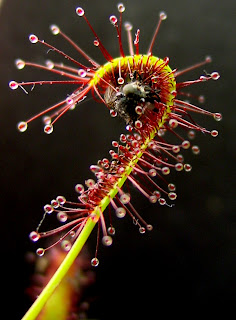There is a relatively simple dogma in a layperson's rules of biology concerning the difference in plants and animals. It is this: Plants make their own food. Animals do not. The resultant food chain or pyramid begins with food producers (plants) at the bottom and food consumers (animals) at all the layers above the producer layer. The difference between plant and animal is so categorically different, that they are organized by taxonomists into separate kingdoms...and there are only 5 (or 6) kingdoms of life. There is, of course, no overlap.
However, it really isn't that simple. First of all, there are plants out there that, in addition to using photosynthesis to make their own food, can capture and consume prey, albeit in a rudimentary fashion (some 630 species worldwide). Plants like the Venus Flytrap, Pitcher Plants, Flypaper Plants, Bladder Traps, Lobster-pot Traps, and other plants in a similar category (an additional 300 species) have evolved to flaunt such biological categorical dogma as the plant-animal divide. The existence of these plants proves that evolution by natural selection, one of the foundational laws of biology, knows no bounds or category and will capitalize on any naturally-existing phenomenon in order to gain some tangible advantage in survival. Although elm trees aren't hunting gazelles on some exotic savanna quite yet, the nature of these plants who behave like animals is nothing short of extraordinary. Want to know what is even crazier? You can OWN some of these plants as houseplants. That's right...you can flaunt biological dogma in your own living room.
 |
| Venus Flytrap courtesy of Wikipedia |
To add to the crazy-factor, this sea slug might be accomplishing photosynthesis by way of a little trick called Horizontal Gene Transfer (you can read AstroExo's write up on HGT here). This is a method by which an organism is able to take in genetic material from a different organism and express it as its own, a game-changer as far as the evolutionary tree is concerned. These implications are being researched by the above mentioned Rumpho-Kennedy, among others here and there around the world.
Despite this incredible ability to "borrow" photosynthesis from another organism, the Eastern Emerald Elysia cannot generate these photosynthesis tools on its own, despite possibly having "photosynthesis-supporting genes" in its DNA by way of Horizontal Gene Transfer. It must happen with each sea slug generation, with each individual.
Another organism called the Pea Aphid, however, has taken the game one step further. This aphid, too, is a creature capable of some degree of Horizontal Gene Transfer. In a new study out in Nature, led by Jean Christophe Valmalette, a particular species of aphid (Acrythosiphon pisum) seems to be producing its own carotenoids - an organic pigment that absorbs light for the purposes of photosynthesis. In fact, apart from this species of aphid, no animal of any kind was thought to be able to do this, so in-and-of itself, this finding is pretty remarkable.
Carotenoids are important for animal life and must be acquired by consuming plant life. Carotenoids aid the immune system in animals and are crucial in the production of certain vitamins. In humans, carotenoids are antioxidants and particular ones aid in protecting the eyes from harmful UV light (eat your carrots, folks!). However, it turns out that the aphids in question are not just making their own carotenoids; they are using them the way a plant might - to make their own energy. Specifically, the carotenoids are thought to capture sunlight exactly as they do in plants, and then aid in the production of energy within the aphids own cells. A selection of statements from the paper in Nature:
- "We report here that the capture of light energy in living aphids results in the photo induced electron transfer from excited chromophores to acceptor molecules. The redox potentials of molecules involved in this process would be compatible with the reduction of the NAD+ coenzyme. This appears as an archaic photosynthetic system consisting of photo-emitted electrons that are in fine funnelled into the mitochondrial reducing power in order to synthesize ATP molecules"
- "This suggests a probable in situ carotene synthesis and at this stage makes the aphids unique in the insect class. On the other side, the availability of free carotenoid pigments in phloem sap on which the aphids feed is very unlikely, because of their hydrophobicity."
- "We suggest that these complex pigments constitute a system of photo-induced electron transfer that (due to their high energy) are able to reduce efficiently NAD+ bound to membrane proteins ending in fine with ATP synthesis."What the researchers are saying in this paper is that they examined this particular aphid species and found that those aphids with certain native carotenoid levels - carotenoids not coming from their food source - have high corresponding ATP levels (forgot what ATP is?). Those ATPs appear to be tied in to the organism's production of energy. While carotenoids are not the primary source for food for the aphid, they probably function as a battery back-up, something to simply aid in the organism's survival. Although this aphid species is quite an interesting little creature, more research is clearly needed.
 |
| A kind of Sundew, a carnivourous plant, with ensnared prey. Photo by Noah Elhardt |
Check out the original paper in Nature right here.
Write up in Nature News about photosynthetic aphids.
Smithsonian Magazine explains the issue fairly well.
What Phys.org has to say about it all.
As usual, io9 breaks it down.
Wired.com does the story some quick justice.
Photosynthetic aphids get the HuffPo treatment.




No comments:
Post a Comment